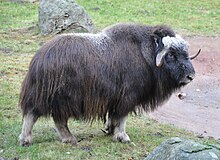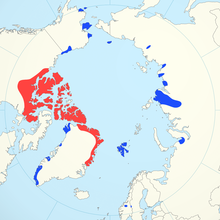Muskoxen
| Muskox Temporal range: 0.2–0 Ma – Recent |
|
|---|---|
 |
|
| Muskox in the Lüneburg Heath wildlife park in Germany. | |
| Scientific classification | |
| Kingdom: | Animalia |
| Phylum: | Chordata |
| Class: | Mammalia |
| Order: | Artiodactyla |
| Family: | Bovidae |
| Subfamily: | Caprinae |
| Genus: |
Ovibos Blainville, 1816 |
| Species: | O. moschatus |
| Binomial name | |
|
Ovibos moschatus (Zimmermann, 1780) |
|
 |
|
| Range map: blue indicates areas where muskox introduction has been attempted in the 20th century; red indicates the previous established range. | |
The muskox (Ovibos moschatus), also spelled musk ox and musk-ox, in Inuktitut ᐅᒥᖕᒪᒃ, umingmak, is an Arctic mammal of the family Bovidae, noted for its thick coat and for the strong odor emitted during the seasonal rut by males, from which its name derives. This musky odor is used to attract females during mating season. Its Inuktitut name "umingmak" translates to "the bearded one."Muskoxen primarily live in the Canadian Arctic and Greenland, with small introduced populations in Sweden, Siberia, Norway, and Alaska.
As members of the subfamily Caprinae of the family Bovidae, muskoxen are more closely related to sheep and goats than to oxen; however, they are placed in their own genus, Ovibos (Latin: "sheep-ox"). The muskox is one of the two largest extant members of Caprinae; along with the similarly sized takin. While takin and muskox were once considered possibly related, the takin lacks common ovibonine features, such as the muskox's specialized horn morphology, and genetic analysis shows that their lineages actually separated early in caprine evolution. Instead, the muskox's closest living relatives appear to be the gorals of the genus Naemorhedus, nowadays common in many countries of central and east Asia. The vague similarity between takin and muskox must therefore be considered an example of convergent evolution.
...
Wikipedia

